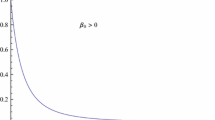Abstract
In extended thermodynamic the entropy principle and the Galilean invariance dictate respectively constraints for the constitutive equations and the velocity dependence. The entropy principle in particular requires the existence of a privileged field, the main field u′, such that the original system becomes symmetric hyperbolic and is generated by four potentials. It is not easy to solve the restrictions of both principles, if we use as field the non convective main field \(\widehat{\mathbf{u}}^{\prime}\ \)and the velocity v. This is due to the fact that \(\widehat{\mathbf{u}}^{\prime}\) are not independent. Rather its components satisfy three scalar constraints. The aim of this paper is to solve the full problem using as new strategy to consider \(\widehat{\mathbf{u}}^{\prime}\ \)as independent variables and requiring an appropriate differential constraint. This new procedure is very efficient and we are able to solve the problem of 13 moments in the full non linear case (far from equilibrium). It turns out that the knowledge of only the equilibrium state function is sufficient to close the system.
Keywords: Extended Thermodynamics, Entropy Principle, Galilean invariance, Rarefied Gas, Hyperbolic systems
Mathematics Subject Classification (2000): 74A20, 76P05, 35l60
Similar content being viewed by others
References
1. Müller, I., Ruggeri, T.: Rational Extended Thermodynamics. Springer Tract in Natural Philosophy 37, Springer, New York (1998)
2. Ruggeri, T.: Galilean Invariance and Entropy Principle for Systems of Balance Laws. Continuum Mech. Thermodyn. 1, 3 (1989)
3. Boillat, G.: Sur l'existence et la recherche déquations de conservation supplémentaires pour les Systémes Hyperboliques. C.R. Acad. Sc. Paris 278, 909 (1974). CIME Course: Recent Mathematical Methods in Nonlinear Wave Propagation. Lecture Notes in Mathematics 1640, 103, T. Ruggeri (Ed.), Springer-Verlag (1995)
4. Ruggeri, T., Strumia, A.:Main field and convex covariant density for quasi-linear hyperbolic systems. Relativistic fluid dynamics. Ann. Ist. H. Poincaré 34, 65 (1981)
5. I-Shih Liu, Müller, I.: Extended Thermodynamics of Classical and Degenerate Ideal Gases. Arch. Rational Mech. Anal. 83, 285 (1983)
6. Grad, H.: On the kinetic theory of rarefied gases. Comm. Appl. Math. 2 (4), 331 (1949)
7. Boillat, G., Ruggeri, T.: Hyperbolic Principal Subsystems: Entropy Convexity and Sub characteristic Conditions. Arch. Rat. Mech. Anal. 137, 303–320 (1997)
8. Pennisi, S.: Higher order terms in Extended Thermodynamics. Continuum Mech. Thermodyn. 10, 29 (1999)
9. Boillat, G., Ruggeri, T.: Moment Equations in the Kinetic Theory of Gases and Wave Velocities. Continuum Mech. Thermodyn. 9, 205 (1997)
Author information
Authors and Affiliations
Rights and permissions
About this article
Cite this article
Pennisi, S., Ruggeri, T. A new method to exploit the Entropy Principle and galilean invariance in the macroscopic approach of Extended Thermodynamics . Ricerche mat. 55, 159–179 (2006). https://doi.org/10.1007/s11587-006-0019-5
Received:
Accepted:
Issue Date:
DOI: https://doi.org/10.1007/s11587-006-0019-5



